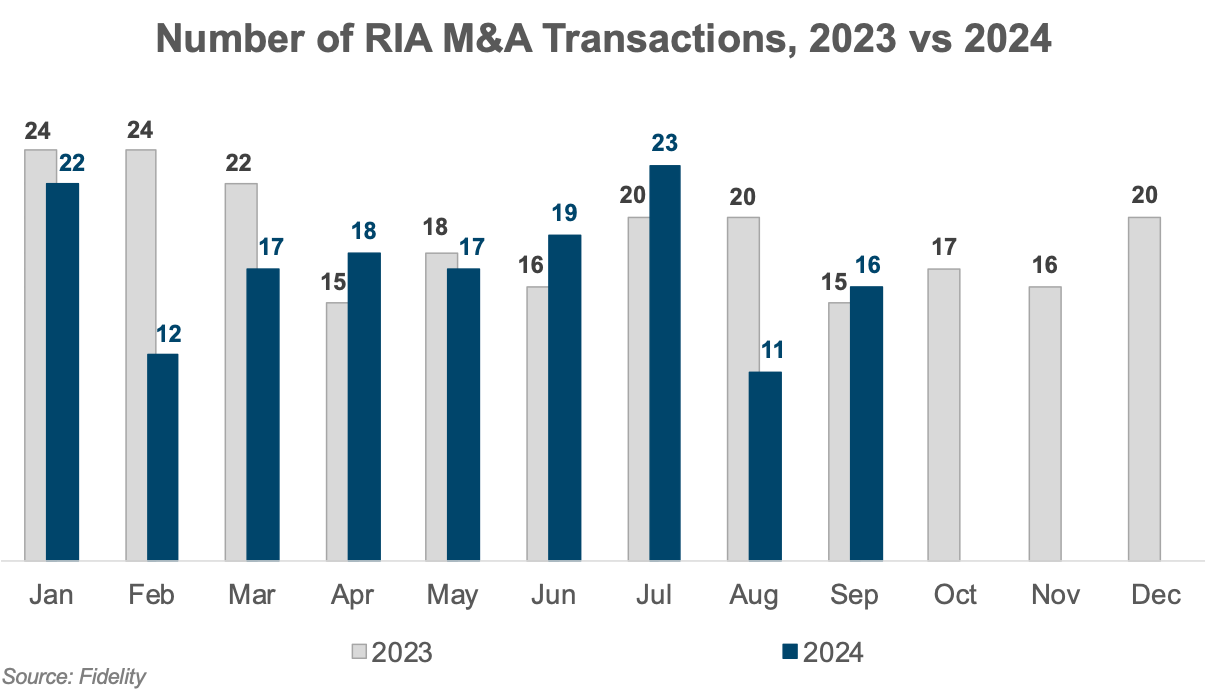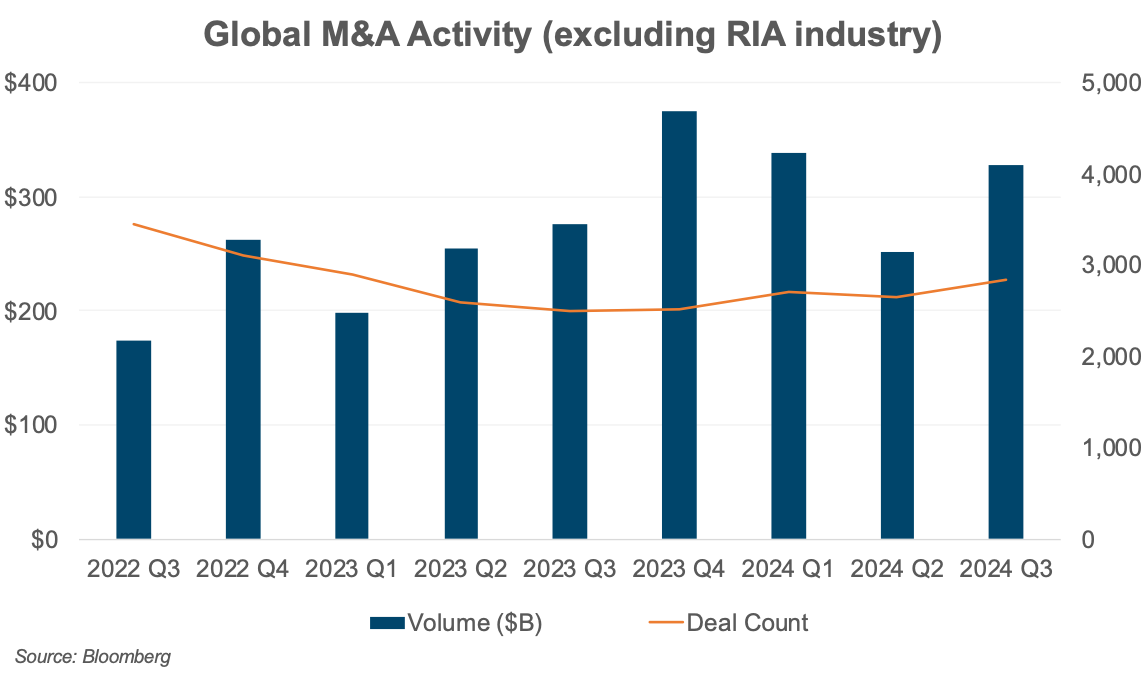RIA M&A Update: Q3 2024
Following a year where deal volume in the RIA industry nearly matched the all-time high of 2022, RIA M&A activity has cooled in 2024. Fidelity’s September 2024 Wealth Management M&A Transaction Report listed 155 deals through September 2024, down 11% from the 174 deals executed during the same period in 2023.

RIA deal activity experienced a greater decline than the broader M&A market. The number of M&A transactions for all industries (excluding the RIA industry) increased 3% year-over-year through the first three quarters of 2024 (per Bloomberg), compared to a decline of 11% in the RIA industry.

Despite the decline in the total number of deals, there was a significant uptick in total transacted AUM during 2024. Total transacted AUM through the first three quarters of 2024 was $541.5 billion—a 168% increase from the same period in 2023. The average AUM per transaction during the first nine months of 2024 was $3.5 billion, a 201% increase over the prior year. The increase in deal size has been an encouraging sign, given the rise in the cost of capital over the past two years. The growth in deal size resulted from the completion of several significant transactions during 2024, coupled with the overall increase in AUM levels due to market performance.
Private equity backing was involved in 63% of the M&A transactions reported in September
Another contributor to the increase in deal size has been RIAs partnering with private equity firms. According to Fidelity’s September 2024 Wealth Management M&A Transaction Report, private equity backing was involved in 63% of the M&A transactions reported in September. Noteworthy transactions backed by private equity in the third quarter include KKR’s acquisition of Janney Montgomery Scott LLC from Penn Mutual Life Insurance. Janney is a leading wealth management and investment banking firm with over $150 billion in assets under administration, and more than 900 financial advisors across the U.S. KKR views this acquisition as a strategic move to strengthen its presence in the U.S. wealth management sector.
The prevalence of serial acquirers and aggregators has continued in the RIA M&A market. In recent years, the professionalization of the buyer market and the entrance of outside capital have driven demand and increased competition for deals. Serial acquirers and aggregators have increasingly contributed to deal volume, supported by dedicated deal teams and access to capital. Such firms accounted for approximately 66% of transactions through September of 2024. Focus Financial Partners, Wealth Enhancement Group, and Sequoia Financial Group all completed multiple deals in the third quarter of 2024.
The professionalization of the buyer market and the entrance of outside capital have driven demand and increased competition for deals
Deal activity has also been supported by the supply side of the M&A equation, as the impetus to sell is often based on more than market timing. Sellers are often looking to solve succession issues, improve quality of life, and access organic growth strategies. Such deal rationales are not sensitive to the market environment and will likely continue to fuel the M&A pipeline even during market downturns.
Another development that could stimulate M&A volume was the Federal Reserve’s decision to cut interest rates by 50 basis points in September. This marks a shift after two and a half years of rate increases, which contributed to a slowdown in deal volume during that period. With expectations of further rate cuts ahead, cheaper capital would likely encourage more deal activity in the RIA M&A market. As capital becomes more accessible and consolidation trends continue, the RIA market could experience renewed momentum heading into 2025.
What Does This Mean for Your RIA?
For RIAs planning to grow through strategic acquisitions: Pricing for RIAs has trended upwards in recent years, leaving you more exposed to underperformance. Structural developments in the industry and the proliferation of capital availability and acquirer models will likely continue to support higher multiples than the industry has seen in the past. That said, a long-term investment horizon is the greatest hedge against valuation risks. Short-term volatility aside, RIAs continue to be the ultimate growth and yield strategy for strategic buyers looking to grow their practice or investors capable of long-term holding periods. RIAs will likely continue to benefit from higher profitability and growth than their broker-dealer counterparts and other diversified financial institutions.
For RIAs considering internal transactions: We’re often engaged to address valuation issues in internal transaction scenarios, where valuation considerations are top of mind. Internal transactions don’t occur in a vacuum, and the same factors driving consolidation and M&A activity have also influenced valuations in internal transactions. As valuations have increased, financing in internal transactions has become a crucial secondary consideration where buyers (usually next-gen management) lack the ability or willingness to purchase a substantial portion of the business outright. As the RIA industry has grown, so too has the number of external capital providers who will finance internal transactions. A seller-financed note has traditionally been one of the primary ways to transition ownership to the next generation of owners (and, in some instances, may still be the best option). Still, increasing bank financing and other external capital options can provide selling partners with more immediate liquidity and potentially offer the next-gen cheaper financing costs.
If you are an RIA considering selling: Whatever the market conditions are when you go to sell, it is essential to have a clear vision of your firm, its value, and what kind of partner you want before you go to market. As the RIA industry has grown, a broad spectrum of buyer profiles has emerged to accommodate different seller motivations and allow for varying levels of autonomy post-transaction. A strategic buyer will likely be interested in acquiring a controlling position in your firm and integrating a significant portion of the business to create scale. At the other end of the spectrum, a sale to a patient capital provider can allow your firm to retain its independence and continue operating with minimal outside interference. Given the wide range of buyer models out there, picking the right buyer type to align with your goals and motivations is a critical decision that can significantly impact personal and career satisfaction after the transaction closes.
About Mercer Capital
We are a valuation firm that is organized according to industry specialization. Our Investment Management Team provides valuation, transaction, litigation, and consulting services to a client base consisting of asset managers, wealth managers, independent trust companies, broker-dealers, PE firms and alternative managers, and related investment consultancies.
 RIA Valuation Insights
RIA Valuation Insights 






